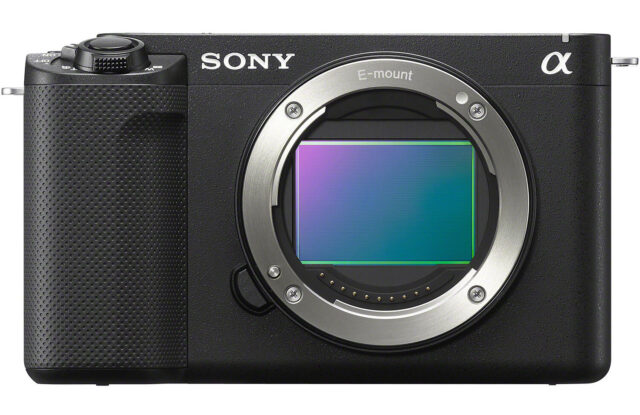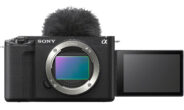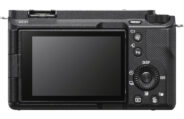Announced
Production status
System
Sony ZV-E1
35mm AF digital mirrorless camera
Specification
| Format: | |
| 35mm full frame | |
Imaging sensor: | 35.6 × 23.8mm CMOS sensor |
Resolution: | 4240 × 2832 - 12 MP |
Sensor-shift image stabilization: | Yes |
| Sony E [18mm] | |
| Shutter: | |
Type: | Focal-plane |
Model: | Electronically controlled |
Speeds: | 30 - 1/8000 + B |
| Exposure: | |
Exposure metering: | Through-the-lens (TTL), open-aperture |
Exposure modes: | Programmed Auto |
| Aperture-priority Auto | |
| Shutter-priority Auto | |
| Manual | |
| Physical characteristics: | |
Weight: | 399g |
Dimensions: | 121x71.9x54.3mm |
Manufacturer description
SAN DIEGO, March 29, 2023 /PRNewswire/ -- Sony Electronics announced today the new ZV-E1, an interchangeable lens camera with a high performance 35mm full-frame image sensor for the ultimate video creation experience. Newly positioned in Sony's ZV vlog camera line-up, the ZV-E1 boasts a 12MP full-frame image sensor, Sony's latest BIONZ XR image processing engine, a dedicated AI (artificial intelligence) processing unit, compatibility with over 70 Sony E-mount lenses, and other advanced technologies for capturing cinematic imagery with rich colors, low noise and high precision. The world's most compact, lightweight full frame interchangeable lens camera, the ZV-E1 offers outstanding mobility, with refined operation to give video creators maximum creative freedom and versatility.
"The ZV-E1 has been designed to deliver a premium content creation tool for video creators who want to elevate their content," says Yang Cheng, Vice President, Imaging Solutions, Sony Electronics Inc. "We are constantly listening to feedback from our customers, pushing to innovate to meet their demands. We have taken all the information into mind with our development of this new camera – with more sophisticated video features, a streamlined user experience and an extremely compact design, the ZV-E1 offers a whole new way for today's creators to create top level video content."
Expressive imagery that emphasizes the subject
The ZV-E1 is a dedicated content creation camera that features a 35mm full-frame back-illuminated CMOS Exmor R™ sensor, with approximately 12.1 effective megapixels, delivering high sensitivity, low noise and gorgeous bokeh.
With up to eight times more processing power than previous Sony processors, the new BIONZ XR™ image processing engine markedly boosts high-sensitivity performance, gradation rendering, color reproduction, low-noise performance, and more. The high volume of data generated by the image sensor can be processed in real time, even when shooting 4K (QFHD: 3840 x 2160) footage at 120p. The BIONZ XR processor also contributes significantly to improved AF speed and precision.
High-quality 4K (QFHD) video can be recorded with full pixel readout at 10-bit 4:2:2, without the need for pixel binning and with very high speed to minimize rolling shutter. This makes the expressive advantages of the full-frame format available for video recording while delivering high-resolution 4K footage. Users can upgrade from 4K 60p to 4K 120p through the Creators' Cloud for extraordinarily smooth 5x (max.) slow-motion imagery. Direct playback for video in slow or quick motion in the S&Q mode boasts outstanding image quality.
With 15+ stop latitude, it's possible to capture natural looking images in a wide variety of lighting to capture natural looking images even in extraordinarily low light situations without losing highlight or shadow detail. The standard ISO range extends from 80 to 102400 for both stills and movies. The expanded range for stills is 40 to 409600, and the expanded range for movies is 80 to 409600.
Turn cinematic dreams into reality
The ZV-E1 can create standout content with Cinematic Vlog Settings, an intuitive way to capture scenes with the cinematic look of feature movies. By choosing an appropriate Look, Mood and AF transition speed, anyone can create cinematic footage that ideally matches the scene and creative intent. The overall cinematic feel is further enhanced by a 24 fps frame rate and the widescreen Cinemascope aspect ratio (2.35:1).
For a truly cinematic look, the ZV-E1 features S-Cinetone, a unique Sony feature which can create a cinematic look straight out of the camera without post-processing. Based on Sony's Cinema Line technology, S-Cinetone delivers natural mid-tones that are essential to healthy-looking skin color to deliver cinematic quality.
A selection of new Creative Looks makes it easy to create interesting appearances for stills and video right in the camera. Ten Creative Looks are provided as presets that can be used as they are or customized with the touch of a button. Newly added My Image Style makes it possible to shoot in the Intelligent Auto or Scene Selection mode; icons on the touch-sensitive monitor make it easy to directly adjust background bokeh, brightness, and color tone, as well as select a Creative Look.
AI plus leading technology delivers consistently stunning imagery
The ZV-E1 features a dedicated, powerful AI (artificial intelligence) processing unit that leverages Sony's technologies to uniquely overcome the challenges of self-taken footage faced by "crew of one" creators. By using AI human recognition, newly developed features of Multiple Face Recognition, Auto Framing, Framing Stabilizer and even Auto Microphone directivity have now become possible. For the first time, the ZV-E1 allows for true self-taken footage and even minimizes or eliminates the need for a second shooter.
Real-time Recognition AF incorporates an innovative AI processing unit that uses subject form data to accurately recognize movement - human pose estimation technology uses learned human forms and postures to recognize not just eyes, but body and head position with high precision, making it possible to lock onto and track a subject facing away from the camera. The AI processing unit can even differentiate between multiple subjects having different postures and recognition of individual faces so that tracking reliability is achieved in challenging situations such as when a subject's face is tilted, in shadow, or backlit. In addition to Human and Animal, the AI processing unit now makes it possible to recognize Bird, Insect, Car/Train and Airplane subjects, providing even greater flexibility and reliability when shooting both stills and video.
The camera features Multiple Face Recognition which automatically adjusts bokeh and focus on multiple recognized faces when shooting group selfies or group portraits - preventing problems like only the faces in the front being in focus while others further back are out of focus. Breathing Compensation suppresses image shifts when focusing to maintain a consistent angle of view and achieve smooth focusing effects.
The ZV-E1 features AI-based Real-time Tracking that can be activated by specifying the subject and half-pressing the shutter button. The camera will then automatically track the subject, leaving the user free to concentrate on framing and composition. The new camera has a fast Hybrid AF for fast acquisition and tenacious tracking as well detailed AF settings for ultimate precision and control.
Another new feature of the ZV-E1 is the AI-based Auto Framing for video which is ideal for recording interviews, music performances, cooking, and much more. Using AI-based subject recognition technology, the Auto Framing feature automatically crops the frame to the users desired level, keeping the subject in a prominent position when shooting video. Even when the camera is mounted on a tripod, for example, the framing is continually adjusted so that the recorded footage looks like the subject is being followed by an experienced camera operator, ideal for a single person shooting scenario.
A compact, 5-axis stabilization unit and gyro sensors with optimized algorithms achieve up to 5.0-step stabilization. The in-body image stabilization of the camera provides effective stabilization with a wide range of lenses, including E-mount lenses that do not include their own stabilization. Dynamic active Mode stabilization is approximately 30% more effective than what Active Mode provides. This makes it easier than ever to shoot smooth, stable footage while moving around for bold, dynamic expression. The ZV-E1 also boasts a Framing Stabilizer that uses advanced AI-based subject recognition in conjunction with the camera's Dynamic active mode image stabilization to automatically keep the subject's position in the frame constant.
The camera also features a Bokeh Switch for one-touch background bokeh enhancement and of course, the ZV-E1 also includes the Product Showcase Setting in the rest of the Sony ZV line, designed for product review videos and allowing users to smoothly switch focus from the presenter's face to a product and back.
Control time to capture unforgettable moments and situations
In-camera time-lapse creation is a great feature for users who want to record time-lapse video sequences like the movements of clouds, people, cities and other slowly changing subjects in uniquely expressive ways. The exposure interval can be set from 1 second to 60 seconds, making it easy to compress slow action into enjoyable time-lapse sequences. Interval shooting used to capture individual still images at intervals greater than 60 seconds is also available.
Advanced audio for winning content
The ZV-E1 features a high-performance 3-capsule microphone with variable directivity to optimize clear and crisp audio recordings. Front, all directions, and rear directivity settings are available to match a variety of environments, and for the first time, automatically switches to a direction in line with face recognition, so users can easily make optimal recordings. The new Auto setting allows [Front] or [All Directions] directivity to be automatically selected according to the current subject recognition and tracking status. The camera also includes a Multi Interface (MI) shoe with digital audio interface and mic and headphone jacks offer expanded audio capabilities. Supplied with the camera, is a windscreen that can significantly reduce noise when shooting in windy conditions.
Advanced and in-depth editing support gets the creator's intent across
The ZV-E1 can record 10-bit 4:2:2 video internally when using Long GOP or All Intra compression, supports internal intra-frame (All-I) recording and XAVC HS format recording using the MPEG-H HEVC/H.265 codec provides approximately doubled efficiency.
The camera has Flexible ISO, which can be set to AUTO or manually set between 640 and 102400 (160 and 409600 in expanded ISO mode). Picture profiles with assignable LUTs are available so users can create specific looks when shooting in modes other than one of the preset Log modes.
The ZV-E1 records image stabilization and camera rotation metadata that can be useful when editing in the free Catalyst Browse desktop application, paid Catalyst Prepare desktop application or plugin as users can quickly and precisely stabilise footage during editing. Lens breathing compensation can be applied during editing.
Designed for easy content creation
The ZV-E1 has been designed for ease of use, with a side-opening vari-angle, 3 inch type 1.07 Mdot LCD Screen for easy monitoring, a touch function while recording and control layout and grip optimized for content creation.
The new camera features uninterrupted power for extended recording with Sony's high-capacity Z battery and USB PD (Power Delivery) that supports fast charging. The ZV-E1 also features a dust and moisture resistant design.
Stream top-quality live content as when connected to a personal computer or smartphone via USB the ZV-E1 can function as a 4K (2160p) webcam and take online meetings, live events, and even simple conversations with family and friends to new creative heights.
Creators' Cloud and easy smartphone connection
Creators can connect and share content easily with Sony's newly announced Creator's Cloud platform and easy smartphone connection.
The Creator's App can be used to control the ZV-E1 from the smartphone, and transfer stills and videos shot on the camera to the smartphone. Camera battery and media status can be monitored from the smartphone, and date and camera names can be edited as needed. The Creator's App also provides a convenient way to update camera software.
Designed with sustainability in mind
In addition to Sony's commitment to a sustainable future with global initiatives like Road to Zero and the 2030 renewable energy goal, the ZV-E1 has been specifically developed with sustainability in mind.
The camera has a newly developed windscreen using fibers made from recycled PET bottles to reduce Sony's environmental impact, without compromising functionality. Lastly, the outer packaging of the ZV-E1 is environmentally conscious and recyclable with no plastic and employs Sony's 'Original Blend Material' – bamboo, sugar cane and recycled paper. Also, plant-based non-woven fabrics are used for the product bags to minimize Sony's environmental footprint.
Also, ZV-E1 includes accessibility features that facilitate operation in several ways, including screen reader functionality for the visually impaired. Accessibility features allow anyone to enjoy shooting and playback using the ZV-E1.




